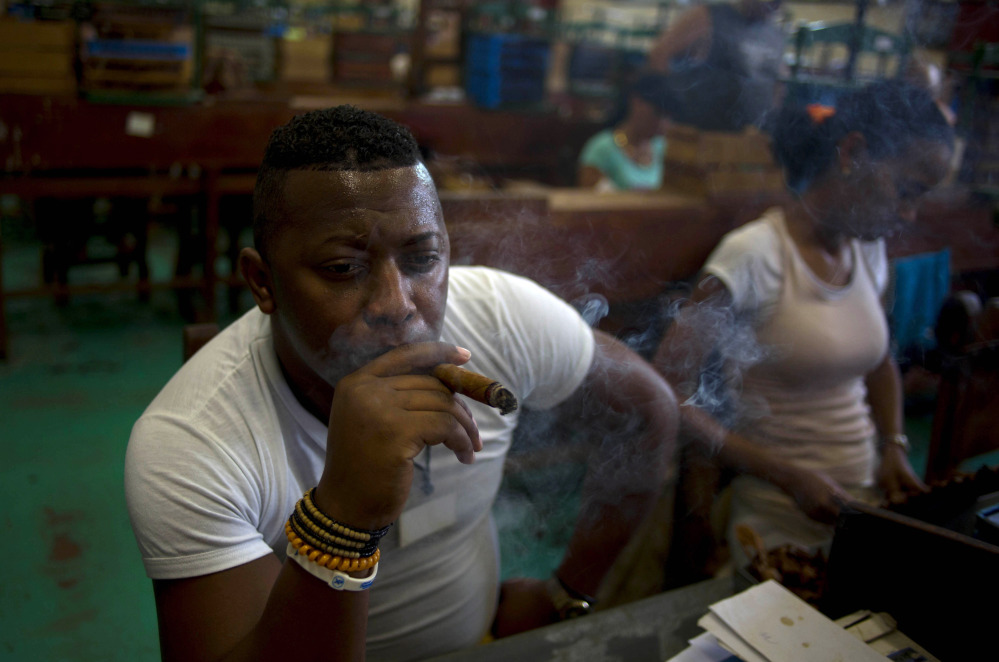HAVANA — Over six decades rolling premium cigars with his small, wrinkled hands, Arnaldo Alfonso has taken pride in seeing his “habanos” sampled by visiting heads of state and other dignitaries.
Now he’s delighted by the idea of customers lighting them up in New York, Los Angeles and elsewhere in the United States, where Cuban cigars have been outlawed since the U.S. embargo took effect in 1962.
“It’s a very beautiful thought,” said a smiling Alfonso, a 78-year-old worker at the tobacco shop of the Palco Hotel in western Havana.
Cuban cigar makers are licking their chops over new U.S. rules, announced in December as part of a partial detente, allowing more Americans to travel to the island and legally bring back small quantities of the coveted stogies for the first time in decades.
As Havana celebrated the annual Cigar Festival that wraps up with a gala-dinner bash Friday, officials said that this year alone they expect to double on-island sales of hand-rolled cigars, known here as “habanos,” from 3 million to 6 million.
“This is an important jump in just one year,” said Jorge Luis Fernandez Maique, vice president of Habanos SA, a mixed venture between Cuba’s state-run Cubatabaco and the British company Altadis. “It’s a boom for the Cuban market.”
The additional sales would represent a modest increase to the company’s overall annual production of around 90 million to 100 million premium units to meet domestic and international demand, primarily in Europe and China.
But officials see it as just the tip of the cigar: If the U.S. embargo were to fall amid a normalization of diplomatic relations, Habanos believes it could capture nearly a third of the American market, the world’s largest for cigars.
Almost 600,000 visitors traveled to the island from the United States last year, a figure that includes mostly Cuban-Americans on family visits but also tens of thousands of people on legal educational and religious exchanges.
Under the new rules, U.S. travelers are now allowed to bring back up to $100 in combined tobacco and alcohol products, a lot less than the $3,000 to $4,000 sales that Diaz can ring up for some of the Canadian, European and Chinese aficionados who shop there.
U.S. visitors can smoke as many cigars as they like while on the island, and can now return with a few five-packs of Montecristo #4 (sale price: $27.75) or Cohiba Siglo I ($34.50) without violating the cap.
If even half of the current number of U.S. travelers were to bring back $50 worth of cigars each, that would add up to some $15 million in new sales for the Habanos company this year.
Getting approval to export cigars to the U.S. would be the real bonanza for Cuba.
Habanos estimates it could sell roughly 70 million to 90 million cigars there, nearly doubling Cuba’s current production, if the embargo were lifted.
There are also questions about Cuba’s ability to ramp up production to eventually meet U.S. demand. The country suffers from major infrastructure deficiencies, and tobacco farmers sometimes complain of transportation delays following the harvest that can cause the leaves to go bad.
“It’s clear that even today, the amounts (harvested) are not enough,” said Ricardo Salas, who distributes Cuban cigars in Cyprus.
Salas and other experts said milder Cuban brands such as Montecristo and Romeo y Julieta would likely do better in the U.S. than the stronger Partagas and Cohiba varieties.
After more than five decades of separation, “the average American doesn’t know the Cuban product,” said Salas. “They have as a comparison Central American or Dominican tobacco – they’ve become used to that kind of flavor of a softer, more discreet tobacco.”
Send questions/comments to the editors.




Success. Please wait for the page to reload. If the page does not reload within 5 seconds, please refresh the page.
Enter your email and password to access comments.
Hi, to comment on stories you must . This profile is in addition to your subscription and website login.
Already have a commenting profile? .
Invalid username/password.
Please check your email to confirm and complete your registration.
Only subscribers are eligible to post comments. Please subscribe or login first for digital access. Here’s why.
Use the form below to reset your password. When you've submitted your account email, we will send an email with a reset code.